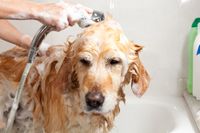
Most dog owners are familiar with the telltale signs of a flea infestation. If your pet doesn’t receive preventative products, they are at risk of becoming a host for the tiny parasites that cause a variety of health problems for dogs. Before taking your dog to the veterinarian, follow the guide below to help treat your dog’s infestation.
How to Rid Your Dog of Fleas
1. Confirm the Infestation
There are many reasons your dog might be itching, so you must confirm that fleas are the culprit. Alongside excessive biting and scratching, watch for hair loss, pale gums, red bumps along the skin, and flea dirt. To find flea dirt, run through your dog’s fur with a flea comb. If any dark brown or black specks come loose, place them on a wet paper towel. The bit should turn reddish brown with water. Flea dirt, which is flea feces, is a sure sign of an infestation.
2. Use Treatments
Fleas go through four life  cycle stages: egg, larva, pupa, and adult. Different treatments target separate steps, so always check their labels. Ask your veterinarian about products that will best suit your pet’s needs. These items may include flea combs, oral medications, specially formulated flea shampoos, and flea spray. Complete elimination will take time and patience. You might need multiple treatments, and you should continue combing and inspecting your dog throughout the process.
cycle stages: egg, larva, pupa, and adult. Different treatments target separate steps, so always check their labels. Ask your veterinarian about products that will best suit your pet’s needs. These items may include flea combs, oral medications, specially formulated flea shampoos, and flea spray. Complete elimination will take time and patience. You might need multiple treatments, and you should continue combing and inspecting your dog throughout the process.
3. Treat Your Home
Even if you rid your dog of fleas, your pet is still at risk. Fleas can survive in carpets, blankets, pet beds, and your backyard. Avoid another infestation by thoroughly treating your home. Wash all bedding with hot water and soap, clean food bowls and toys, vacuum the floors, and use a commercial flea treatment for your yard. If the issue is severe, you may want to call an exterminator. Like your dog’s treatment, eradicating fleas from your home requires patience and may take several months.
4. Start Flea Control
When it comes to stopping fleas, prevention is the best method. As soon as you find these pests, you should put your dog on a flea preventative your veterinarian recommends. These can be topical, oral, or come on special collars. Preventatives kill pests that try to bite your dog, and will even eliminate fleas already attached. They are especially effective when used alongside other treatments. For the best protection, continue using preventatives year-round.
Do you need help handling a possible flea problem? Talk to the knowledgeable staff at Carolina Veterinary Hospital, P.A., of Sanford, NC, for effective parasite prevention and personalized pet medical care. This animal clinic provides comprehensive veterinary service to keep your pet in excellent health, from dentistry and in-house pharmaceuticals to grooming and behavioral counseling. For a detailed list of services, visit their website. Call (919) 258-3349 to schedule an appointment with a veterinarian.
About the Business
Have a question? Ask the experts!
Send your question

